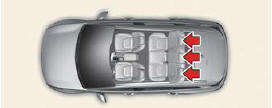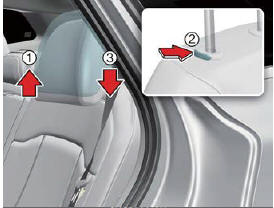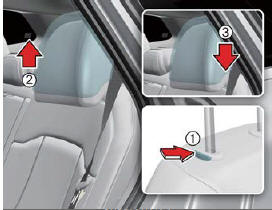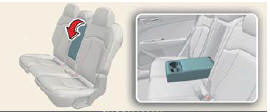Kia Sportage: Headrest for rear seat
The rear seat is equipped with headrests in all the seating positions for the occupant's safety and comfort.
 The headrest
not only provides comfort
for passengers, but also helps protect
the head and neck in the event of a collision.
The headrest
not only provides comfort
for passengers, but also helps protect
the head and neck in the event of a collision.
To maximize the effectiveness in case of accidents, the headrest should be adjusted so the middle of the headrest is as high as the center of gravity of an occupant's head. Generally, the center of gravity of most people's heads is similar with the height as the top of their eyes.
Also, adjust the headrest as close to your head as possible. For this reason, the use of a cushion that holds the body away from the seatback is not recommended.
Adjusting the height up and down

- To raise the headrest, pull it up to the desired position (1).
- To lower the headrest, push and hold the release button (2) on the headrest support and lower the headrest to the desired position (3).
Removal and reinstallation (if equipped)

- To remove the headrest, raise it as far as it can go then press the release button (1) while pulling the headrest upward (2).
- To reinstall the headrest, put the headrest poles (3) into the holes while pressing the release button (1).
Then adjust it to the appropriate height and ensure that it locks in position.
Armrest
Armrest (if equipped)

To use the armrest, pull it forward from the seatback.
READ NEXT:
 Folding the rear seat
Folding the rear seat
The rear seatbacks may be folded to
facilitate carrying long items or to
increase the luggage capacity of the
vehicle.
WARNING
Folded Seatback
The purpose of the fold-down rear seatbacks
is to
 Seat belt restraint system
Seat belt restraint system
Seat belts are designed to bear upon the
bony structure of the body, and should
be worn low across the front of the pelvis,
chest and shoulders.
Seat belt restraint system
For maximum restraint s
SEE MORE:
 Ignition Switch Assembly
Ignition Switch Assembly
Repair procedures
Inspection
1. Disconnect the ignition switch connector (B) and key warning switch
connector (A) from under the steering column.
2. Check for continuity between the terminals.
3. If continuity is not specified, replace the switch.
Removal
1. Disconnect the nega
 Before driving
Before driving
Before getting into the vehicle, you
should examine the vehicle and its surroundings.
After getting into the vehicle,
you should check a number of things
before driving.
Before entering vehicle
Be sure that all windows, outside mirror(
s), and outside lights are clean.
Check the condi
Content
- Home
- Kia Sportage - Fifth generation (NQ5) - (2022-2026) - Owner's Manual
- Kia Sportage - Second generation (JEKM) (2005-2015) - Body Workshop Manual
- Kia Sportage Third generation (SL) - (2011-2016) - Service and Repair Manual
- Sitemap
- Top articles